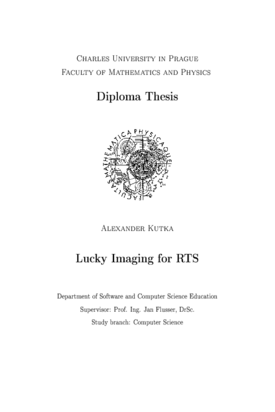Lucky Imaging for RTS2
Lucky Imaging for RTS2
diploma thesis (DEFENDED)

View/
Permanent link
http://hdl.handle.net/20.500.11956/13227Identifiers
Study Information System: 46344
CU Caralogue: 990008448430106986
Collections
- Kvalifikační práce [11368]
Author
Advisor
Referee
Šimberová, Stanislava
Faculty / Institute
Faculty of Mathematics and Physics
Discipline
Software systems
Department
Department of Software and Computer Science Education
Date of defense
18. 9. 2007
Publisher
Univerzita Karlova, Matematicko-fyzikální fakultaLanguage
English
Grade
Very good
S rychlým vývojem CCD detektorů se v astronomii v posledních několika letech začíná používat metoda zvaná Lucky Imaging. Ta, podobně jako adaptivní optika, umožňuje pořizování snímků s rozlišením blízkému difrakčnímu limitu, tedy umožňuje pozemskými přístroji pořizovat obrázky, které mají rozlišení podobné přístrojům umístěným mimo atmosféru. Ve srovnání s adaptivní optikou bývá Lucky Imaging levnější a méně náročný na přítomnost referenčních hvězd. Diplomová práce je implementace Lucky Imagingu do softwarového systému pro řízení pozorování RTS2. Podrobně jsou studovány tři algoritmy pro vyhodnocování ostrosti snímků a jejich výkon je porovnán na snímcích pořízených astronomickým dalekohledem. V druhé části práce jsou studovány dvě metody snímkové registrace, které jsou v práci použity pro potlačení šumu na obrázcích.
Thanks to the rapid development of CCD detectors there is a method called "Lucky Imaging" being used in astronomy in the past years. Like adaptive optics, Lucky imaging makes it possible to gain pictures with resolution close to the diffraction limit, i.e. it gives to ground based telescopes the possibility to gain pictures with the resolution close to the resolution of telescopes placed outside the atmosphere. Lucky imaging is cheaper alternative to Adaptive Optics, with a lower demandingness on the presence of reference stars. This Diploma thesis is an implementation of Lucky Imaging into a software system for robotics observatory control called "RTS2". Three algorithms for evaluation of image focus are studied and their performance is compared on digital images acquired by a telescope. In the second part of the thesis, two methods of image registration are studied, which are used to suppress noise on the acquired images.
